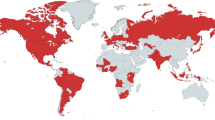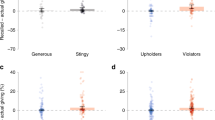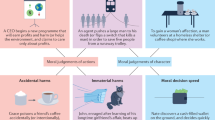Abstract
People form moral impressions rapidly, effortlessly and from a remarkably young age1,2,3,4,5. Putatively ‘bad’ agents command more attention and are identified more quickly and accurately than benign or friendly agents5,6,7,8,9,10,11,12. Such vigilance is adaptive, but can also be costly in environments where people sometimes make mistakes, because incorrectly attributing bad character to good people damages existing relationships and discourages forming new relationships13,14,15,16. The ability to accurately infer the moral character of others is critical for healthy social functioning, but the computational processes that support this ability are not well understood. Here, we show that moral inference is explained by an asymmetric Bayesian updating mechanism in which beliefs about the morality of bad agents are more uncertain (and therefore more volatile) than beliefs about the morality of good agents. This asymmetry seems to be a property of learning about immoral agents in general, as we also find greater uncertainty for beliefs about the non-moral traits of bad agents. Our model and data reveal a cognitive mechanism that permits flexible updating of beliefs about potentially threatening others, a mechanism that could facilitate forgiveness when initial bad impressions turn out to be inaccurate. Our findings suggest that negative moral impressions destabilize beliefs about others, promoting cognitive flexibility in the service of cooperative but cautious behaviour.
This is a preview of subscription content, access via your institution
Access options
Access Nature and 54 other Nature Portfolio journals
Get Nature+, our best-value online-access subscription
$29.99 / 30 days
cancel any time
Subscribe to this journal
Receive 12 digital issues and online access to articles
$119.00 per year
only $9.92 per issue
Buy this article
- Purchase on Springer Link
- Instant access to full article PDF
Prices may be subject to local taxes which are calculated during checkout




Similar content being viewed by others
Data availability
The data that support the findings of this study are available from the corresponding author upon request.
References
Fiske, S. T., Cuddy, A. J. C. & Glick, P. Universal dimensions of social cognition: warmth and competence. Trends Cogn. Sci. 11, 77–83 (2007).
Uleman, J. S. & Kressel, L. M. in Oxford Handbook of Social Cognition (ed. Calston, D. E.) 53–73 (Oxford Univ. Press, Oxford, 2013).
Todorov, A., Pakrashi, M. & Oosterhof, N. N. Evaluating faces on trustworthiness after minimal time exposure. Soc. Cogn. 27, 813–833 (2009).
Engell, A. D., Haxby, J. V. & Todorov, A. Implicit trustworthiness decisions: automatic coding of face properties in the human amygdala. J. Cogn. Neurosci. 19, 1508–1519 (2007).
Kiley Hamlin, J., Wynn, K. & Bloom, P. Three-month-olds show a negativity bias in their social evaluations. Dev. Sci. 13, 923–929 (2010).
Schupp, H. T. et al. The facilitated processing of threatening faces: an ERP analysis. Emotion 4, 189–200 (2004).
Öhman, A., Lundqvist, D. & Esteves, F. The face in the crowd revisited: a threat advantage with schematic stimuli. J. Pers. Soc. Psychol. 80, 381–396 (2001).
Vanneste, S., Verplaetse, J., Hiel, A. V. & Braeckman, J. Attention bias toward noncooperative people. A dot probe classification study in cheating detection. Evol. Hum. Behav. 28, 272–276 (2007).
Skowronski, J. J. & Carlston, D. E. Negativity and extremity biases in impression formation: a review of explanations. Psychol. Bull. 105, 131–142 (1989).
Fiske, S. T. Attention and weight in person perception: the impact of negative and extreme behavior. J. Pers. Soc. Psychol. 38, 889–906 (1980).
Pratto, F. & John, O. P. Automatic vigilance: the attention-grabbing power of approach- and avoidance-related social information. J. Pers. Soc. Psychol. 61, 380–391 (1991).
Baumeister, R. F., Bratslavsky, E., Finkenauer, C. & Vohs, K. D. Bad is stronger than good. Rev. Gen. Psychol. 5, 323–370 (2001).
McCullough, M. E. Beyond Revenge: The Evolution of the Forgiveness Instinct (John Wiley & Sons, San Francisco, CA, 2008).
Axelrod, R. M. The Evolution of Cooperation (Basic Books, New York, NY, 2006).
Molander, P. The optimal level of generosity in a selfish, uncertain environment. J. Conflict Resolut. 29, 611–618 (1985).
Johnson, D. D. P., Blumstein, D. T., Fowler, J. H. & Haselton, M. G. The evolution of error: error management, cognitive constraints, and adaptive decision-making biases. Trends Ecol. Evol. 28, 474–481 (2013).
Cosmides, L. & Tooby, J. in The Adapted Mind: Evolutionary Psychology and the Generation of Culture (eds Barkow, J. H. et al.) 163–228 (Oxford Univ. Press, Oxford, 1992).
Nowak, M. A. & Sigmund, K. Tit for tat in heterogeneous populations. Nature 355, 250–253 (1992).
Wu, J. & Axelrod, R. How to cope with noise in the iterated prisoner’s dilemma. J. Conflict Resolut. 39, 183–189 (1995).
Fudenberg, D., Rand, D. G. & Dreber, A. Slow to anger and fast to forgive: cooperation in an uncertain world. Am. Econ. Rev. 102, 720–749 (2012).
Mathys, C., Daunizeau, J., Friston, K. J. & Stephan, K. E. A Bayesian foundation for individual learning under uncertainty. Front. Hum. Neurosci. 5, 39 (2011).
Ohman, A. Face the beast and fear the face: animal and social fears as prototypes for evolutionary analyses of emotion. Psychophysiology 23, 123–145 (1986).
Nassar, M. R. et al. Rational regulation of learning dynamics by pupil-linked arousal systems. Nat. Neurosci. 15, 1040–1046 (2012).
Reeder, G. D. & Coovert, M. D. Revising an impression of morality. Soc. Cogn. 4, 1–17 (1986).
Mende-Siedlecki, P., Baron, S. G. & Todorov, A. Diagnostic value underlies asymmetric updating of impressions in the morality and ability domains. J. Neurosci. 33, 19406–19415 (2013).
Crockett, M. J., Kurth-Nelson, Z., Siegel, J. Z., Dayan, P. & Dolan, R. J. Harm to others outweighs harm to self in moral decision making. Proc. Natl Acad. Sci. USA 111, 17320–17325 (2014).
Crockett, M. J., Siegel, J. Z., Kurth-Nelson, Z., Dayan, P. & Dolan, R. J. Moral transgressions corrupt neural representations of value. Nat. Neurosci. 20, 879–885 (2017).
Gert, B. Common Morality: Deciding What to Do (Oxford Univ. Press, Oxford, 2004).
Diaconescu, A. O. et al. Inferring on the intentions of others by hierarchical Bayesian learning. PLoS Comput. Biol. 10, e1003810 (2014).
Vossel, S. et al. Spatial attention, precision, and Bayesian inference: a study of saccadic response speed. Cereb. Cortex 24, 1436–1450 (2014).
Behrens, T. E. J., Hunt, L. T., Woolrich, M. W. & Rushworth, M. F. S. Associative learning of social value. Nature 456, 245–249 (2008).
Hackel, L. M., Doll, B. B. & Amodio, D. M. Instrumental learning of traits versus rewards: dissociable neural correlates and effects on choice. Nat. Neurosci. 18, 1233–1235 (2015).
Brañas-Garza, P., Rodríguez-Lara, I. & Sánchez, A. Humans expect generosity. Sci. Rep. 7, 42446 (2017).
Rand, D. G. Cooperation, fast and slow: meta-analytic evidence for a theory of social heuristics and self-interested deliberation. Psychol. Sci. 27, 1192–1206 (2016).
Rosenberg, S., Nelson, C. & Vivekananthan, P. S. A multidimensional approach to the structure of personality impressions. J. Pers. Soc. Psychol. 9, 283–294 (1968).
Robinson, O. J., Vytal, K., Cornwell, B. R. & Grillon, C. The impact of anxiety upon cognition: perspectives from human threat of shock studies. Front. Hum. Neurosci. 7, 203 (2013).
Judd, C. M., James-Hawkins, L., Yzerbyt, V. & Kashima, Y. Fundamental dimensions of social judgment: understanding the relations between judgments of competence and warmth. J. Pers. Soc. Psychol. 89, 899–913 (2005).
Tormala, Z. L. & Rucker, D. D. Attitude certainty: a review of past findings and emerging perspectives. Soc. Pers. Psychol. Compass 1, 469–492 (2007).
Acknowledgements
We thank D. Carlston, E. Boorman, C. Summerfield and T. Behrens for helpful feedback. We thank T. Tyurkina and L. Caviola for developing the web applications utilized in studies 2–7 for data collection. J.Z.S. was supported by a Clarendon and Wellcome Trust Society and Ethics award (104980/Z/14/Z). R.B.R. was supported by a MRC Career Development award (MR/N02401X/1). This work was supported by a Wellcome Trust ISSF award (204826/Z/16/Z), the John Fell Fund and the Academy of Medical Sciences (SBF001/1008). The funders had no role in study design, data collection and analysis, decision to publish or preparation of the manuscript.
Author information
Authors and Affiliations
Contributions
M.J.C. and J.Z.S. conceived the studies. J.Z.S., C.M., R.B.R. and M.J.C. designed the studies. J.Z.S. collected the data. J.Z.S., C.M. and M.J.C. analysed the data. J.Z.S. and M.J.C. wrote the manuscript with edits from R.B.R. and C.M.
Corresponding author
Ethics declarations
Competing interests
The authors declare no competing interests.
Additional information
Publisher’s note: Springer Nature remains neutral with regard to jurisdictional claims in published maps and institutional affiliations.
Supplementary information
Supplementary Information
Supplementary Methods, Supplementary Results, Supplementary Tables 2–4, 6–12 and Supplementary Figures 1–7
Rights and permissions
About this article
Cite this article
Siegel, J.Z., Mathys, C., Rutledge, R.B. et al. Beliefs about bad people are volatile. Nat Hum Behav 2, 750–756 (2018). https://doi.org/10.1038/s41562-018-0425-1
Received:
Accepted:
Published:
Issue Date:
DOI: https://doi.org/10.1038/s41562-018-0425-1
This article is cited by
-
A levels-of-analysis framework for studying social emotions
Nature Reviews Psychology (2024)
-
Neurocomputational mechanisms of biased impression formation in lonely individuals
Communications Biology (2023)
-
People are curious about immoral and morally ambiguous others
Scientific Reports (2023)
-
Blocking D2/D3 dopamine receptors in male participants increases volatility of beliefs when learning to trust others
Nature Communications (2023)
-
Aggressive and psychopathic traits are linked to the acquisition of stable but imprecise hostile expectations
Translational Psychiatry (2023)



